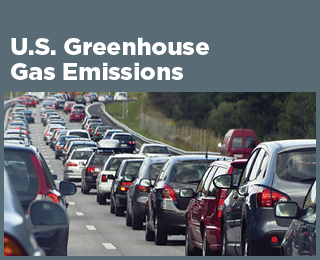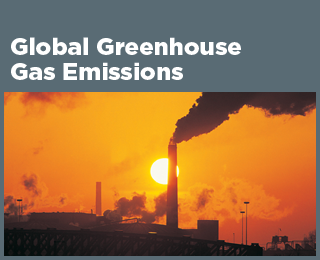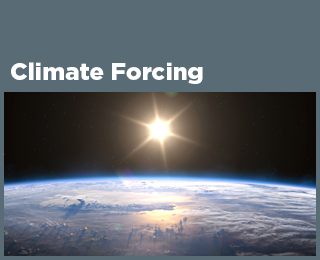Climate Change Indicators: Greenhouse Gases
Greenhouse gases from human activities are the most significant driver of observed climate change since the mid-20th century.1 The indicators in this chapter characterize emissions of the major greenhouse gases resulting from human activities, the concentrations of these gases in the atmosphere, and how emissions and concentrations have changed over time. When comparing emissions of different gases, these indicators use a concept called “global warming potential” to convert amounts of other gases into carbon dioxide equivalents.
Why does it matter?
As greenhouse gas emissions from human activities increase, they build up in the atmosphere and warm the climate, leading to many other changes around the world—in the atmosphere, on land, and in the oceans. The indicators in other chapters of this report illustrate many of these changes, which have both positive and negative effects on people, society, and the environment—including plants and animals. Because many of the major greenhouse gases stay in the atmosphere for tens to hundreds of years after being released, their warming effects on the climate persist over a long time and can therefore affect both present and future generations.
Summary of Key Points
- U.S. Greenhouse Gas Emissions. In the United States, greenhouse gas emissions caused by human activities decreased by 3 percent from 1990 to 2022, down from a high of 15.2 percent above 1990 levels in 2007. Carbon dioxide accounts for most of the nation’s emissions. Transportation is the largest source of 2022 greenhouse gas emissions in the United States, followed by electricity generation. Emissions per person have decreased slightly in the last few years.
- Sources of Data on U.S. Greenhouse Gas Emissions. EPA has two key programs that provide data on greenhouse gas emissions in the United States: the Inventory of U.S. Greenhouse Gas Emissions and Sinks and the Greenhouse Gas Reporting Program. The programs are complementary, providing both a higher-level perspective on the nation’s total emissions and detailed information about the sources and types of emissions from individual facilities.
- Global Greenhouse Gas Emissions. Worldwide, net emissions of greenhouse gases from human activities increased by 44 percent from 1990 to 2015. Emissions of carbon dioxide, which account for about three-fourths of total emissions, increased by 50 percent over this period. As with the United States, the majority of the world’s emissions result from transportation, electricity generation, and other forms of energy production and use.
- Atmospheric Concentrations of Greenhouse Gases. Concentrations of carbon dioxide and other greenhouse gases in the atmosphere have increased since the beginning of the industrial era. Almost all of this increase is attributable to human activities.2 Historical measurements show that the current global atmospheric concentrations of carbon dioxide are unprecedented compared with the past 800,000 years, even after accounting for natural fluctuations.
- Climate Forcing. Climate forcing refers to a change in the Earth’s energy balance, leading to either a warming or cooling effect over time. An increase in the atmospheric concentrations of greenhouse gases produces a positive climate forcing, or warming effect. From 1990 to 2023, the total warming effect from greenhouse gases added by humans to the Earth’s atmosphere increased by 51 percent. The warming effect associated with carbon dioxide alone increased by 42 percent.
Major Greenhouse Gases Associated with Human Activities
| Greenhouse gas | How it's produced | Average lifetime in the atmosphere | 100-year global warming potential |
|---|---|---|---|
| Carbon dioxide | Emitted primarily through the burning of fossil fuels (oil, natural gas, and coal), solid waste, and trees and wood products. Changes in land use also play a role. Deforestation and soil degradation add carbon dioxide to the atmosphere, while forest regrowth takes it out of the atmosphere. | See the footnote* | 1 |
| Methane | Emitted during the production and transport of oil and natural gas as well as coal. Methane emissions also result from livestock and agricultural practices and from the anaerobic decay of organic waste in municipal solid waste landfills. | 11.8 years | 27.0–29.8** |
| Nitrous oxide | Emitted during agricultural and industrial activities, as well as during combustion of fossil fuels and solid waste. | 109 years | 273 |
| Fluorinated gases | A group of gases that contain fluorine, including hydrofluorocarbons, perfluorocarbons, and sulfur hexafluoride, among other chemicals. These gases are emitted from a variety of industrial processes and commercial and household uses and do not occur naturally. Sometimes used as substitutes for ozone-depleting substances such as chlorofluorocarbons. | A few weeks to thousands of years | Varies (the highest is sulfur hexafluoride at 25,200) |
This table shows 100-year global warming potentials, which describe the effects that occur over a period of 100 years after a particular mass of a gas is emitted. Global warming potentials and lifetimes come from Tables 7.15 and 7.SM.7 of the Intergovernmental Panel on Climate Change’s Sixth Assessment Report, Working Group I contribution.3
* Carbon dioxide’s lifetime cannot be represented with a single value because the gas is not destroyed over time, but instead moves among different parts of the ocean–atmosphere–land system. Some of the excess carbon dioxide is absorbed quickly (for example, by the ocean surface), but some will remain in the atmosphere for thousands of years, due in part to the very slow process by which carbon is transferred to ocean sediments.
** Methane's global warming potential is shown as a range that includes methane from both fossil and non-fossil sources.
See Understanding Global Warming Potentials to learn more about the numbers in the table above and the versions EPA uses for various calculations.
Sources of Data on U.S. Greenhouse Gas Emissions
EPA has two key programs that provide data on greenhouse gas emissions in the United States: the Inventory of U.S. Greenhouse Gas Emissions and Sinks and the Greenhouse Gas Reporting Program. The programs are complementary, providing both a higher-level perspective on the nation’s total emissions and detailed information about the sources and types of emissions from individual facilities. The data in EPA’s U.S. Greenhouse Gas Emissions indicator come from the national inventory.
EPA's Inventory of Greenhouse Gas Emissions and Sinks
EPA develops an annual report called the Inventory of U.S. Greenhouse Gas Emissions and Sinks (or the GHG Inventory). This report tracks trends in total annual U.S. emissions by source (or sink), economic sector, and greenhouse gas going back to 1990. EPA uses national energy data, data on national agricultural activities, and other national statistics to provide a comprehensive accounting of total greenhouse gas emissions for all man-made sources in the United States. This inventory fulfills the nation’s obligation to provide an annual emissions report under the United Nations Framework Convention on Climate Change.
Learn more about the inventory and explore the data using interactive tools.
EPA's Greenhouse Gas Reporting Program
Since 2010, EPA’s Greenhouse Gas Reporting Program has been collecting annual emissions data from industrial sources that directly emit large amounts of greenhouse gases. Generally, facilities that emit more than 25,000 metric tons of carbon dioxide equivalents per year are required to report. The program also collects data from entities known as "suppliers" that supply certain fossil fuels and industrial gases that will emit greenhouse gases into the atmosphere if burned or released—for example, refineries that supply petroleum products such as gasoline. The Greenhouse Gas Reporting Program only requires reporting; it is not an emissions control program. This program helps EPA and the public understand where greenhouse gas emissions are coming from, and will improve our ability to make informed policy, business, and regulatory decisions.
Learn more about the Greenhouse Gas Reporting Program and explore data by facility, industry, location, or gas using a data visualization and mapping tool called FLIGHT. You can also review state- or Tribal-specific emissions using interactive fact sheets and download detailed data via EPA's Envirofacts database.
References
1 IPCC (Intergovernmental Panel on Climate Change). 2021. Climate change 2021: The physical science basis. Working Group I contribution to the IPCC Sixth Assessment Report. Cambridge, United Kingdom: Cambridge University Press. www.ipcc.ch/assessment-report/ar6.
2 IPCC (Intergovernmental Panel on Climate Change). 2021. Climate change 2021: The physical science basis. Working Group I contribution to the IPCC Sixth Assessment Report. Cambridge, United Kingdom: Cambridge University Press. www.ipcc.ch/assessment-report/ar6.
3 IPCC (Intergovernmental Panel on Climate Change). 2021. Climate change 2021: The physical science basis. Working Group I contribution to the IPCC Sixth Assessment Report. Cambridge, United Kingdom: Cambridge University Press. www.ipcc.ch/assessment-report/ar6.




